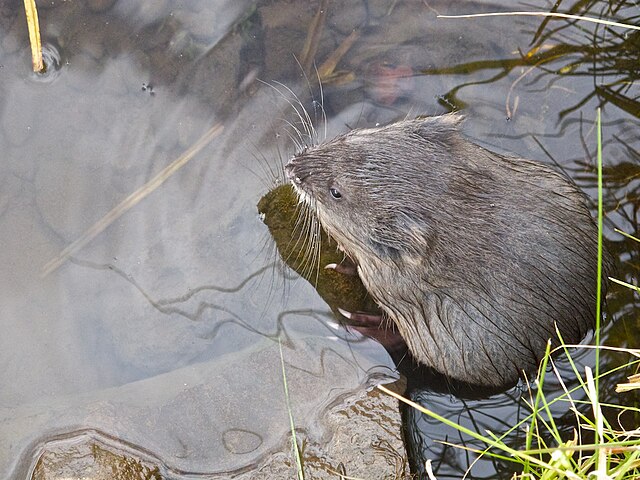Top Qs
Timeline
Chat
Perspective
List of mammals of Yellowstone National Park
From Wikipedia, the free encyclopedia
Remove ads
There are at least 67 species of mammals known to live within Yellowstone National Park, a 2,219,791 acres (898,318 ha)[1] protected area in the Rocky Mountains of Wyoming, Montana, and Idaho. Species are listed by common name, scientific name, typical habitat, and relative abundance.[2]


Remove ads
Canids


Order: Carnivora Family: Canidae
- Coyote (Canis latrans) valleys, grasslands, forests – common
- Northwestern wolf (Canis lupus occidentalis) valleys, grasslands, forests – common
- Wasatch mountain fox (Vulpes vulpes macroura) meadows, forests – common
Bears

Order: Carnivora Family: Ursidae
- Grizzly bear (Ursus arctos horribilis) grasslands, forests, alpine tundra – common
- American black bear (Ursus americanus) forests – common
Raccoons
Order: Carnivora Family: Procyonidae
- Common raccoon (Procyon lotor) rivers, cottonwoods – rare
Felids
Order: Carnivora Family: Felidae
- Cougar (Puma concolor) forests, rock outcrops – uncommon
- Canada lynx (Lynx canadensis) coniferous forests – rare
- Bobcat (Lynx rufus) coniferous forests, rock outcroppings – common
Weasels
Order: Carnivora Family: Mustelidae
- Wolverine (Gulo gulo) alpine tundra, coniferous forests – rare
- North American river otter (Lontra canadensis) rivers – common
- Pacific marten (Martes caurina) coniferous forests – common
- American ermine or short-tailed weasel (Mustela richardsonii) willows, spruce forests – common
- Long-tailed weasel (Neogale frenata) forests, meadows, wetlands – common
- American mink (Neogale vison) streams, rivers – uncommon
- Fisher (Pekania pennanti) forests – rare
- American badger (Taxidea taxus) grasslands, sagebrush – common
Remove ads
Skunks
Order: Carnivora Family: Mephitidae
- Striped skunk (Mephitis mephitis) riparian forests – rare
Rabbits and hares

Order: Lagomorpha Family: Leporidae
- Mountain cottontail (Sylvilagus nuttallii) shrublands – common
- Desert cottontail (Sylvilagus audubonii) shrublands – common
- Snowshoe hare (Lepus americanus) coniferous forests, willows – common
- White-tailed jackrabbit (Lepus townsendii) sagebrush, grasslands – common
Pikas
Order: Lagomorpha Family: Ochotonidae
- American Pika (Ochotona princeps) alpine tundra, rocky areas – common
Bovids

Order: Artiodactyla Family: Bovidae
- Plains bison (Bison bison bison) grasslands, sagebrush, shrubland – abundant
- Rocky Mountain bighorn sheep (Ovis canadensis canadensis) cliffs, rock outcroppings, alpine tundra – uncommon
- Mountain Goat (Oreamnos americanus) cliffs, rock outcroppings, alpine tundra – uncommon (non-native)
Pronghorn

Order: Artiodactyla Family: Antilocapridae
- Pronghorn (Antilocapra americana) sagebrush, grassland – common
Elk, moose, and deer

Order: Artiodactyla Family: Cervidae
- Northwestern white-tailed deer (Odocoileus virginianus ochrourus) grasslands, forests – uncommon
- Rocky Mountain mule deer (Odocoileus hemionus hemionus) grasslands, shrubland, forests – common
- Rocky Mountain elk (Cervus canadensis nelsoni) grasslands, shrubland, forest, alpine tundra – abundant
- Shiras moose (Alces alces shirasi) grasslands, forests, river, lakes – uncommon
Remove ads
Shrews
Order: Soricomorpha Family: Soricidae
- Dusky shrew (Sorex monticolus) meadows, forests – common
- Masked shrew (Sorex cinereous) meadows, forests – common
- American water shrew (Sorex palustris) meadows, riparian areas – common
- Preble's shrew (Sorex preblei) meadows, forests – rare, if present
- Dwarf shrew (Sorex nanus) meadows, forests – common.
Beavers
Order: Rodentia Family: Castoridae
- American beaver (Castor canadensis) riparian areas – fairly common, increasing
Squirrels

Order: Rodentia Family: Sciuridae
- Least chipmunk (Neotamias minimus) meadows, forests – common
- Uinta chipmunk (Neotamias umbrinus) meadows, forests – common
- Yellow-pine chipmunk (Neotamias amoenus) meadows, forests – common
- American red squirrel (Tamiasciurus hudsonicus) coniferous forests – common
- Northern flying squirrel (Glaucomys sabrinus) forests – occasional
- Yellow-bellied marmot (Marmota flaventris) forests, meadows, rocky areas – common
- Uinta ground squirrel (Urocitellus armatus) meadows, sagebrush – common
- Golden-mantled ground squirrel (Callospermophilus lateralis) meadows, forests, rocky areas, alpine tundra – common
Voles and Woodrats

Order: Rodentia Family: Cricetidae
- Common muskrat (Ondatra zibethicus) riparian – occasional
- Western heather vole (Phenacomys intermedius) sagebrush, grasslands, forest – occasional
- Water vole (Microtus richardsoni) riparian – occasional
- Long-tailed vole (Microtus longicaudus) meadows – common
- Southern red-backed vole (Myodes gapperi) coniferous forests – common
- Meadow vole (Microtus pennsylvanicus) meadows – common
- Montane vole (Microtus montanus) meadows, sagebrush, riparian – common
- Bushy-tailed woodrat (Neotoma cinerea) rocky areas – common
Mice

Order: Rodentia Family: Cricetidae
- Deer mouse (Peromyscus maniculatus) grasslands – common
Jumping mice
Order: Rodentia Family: Dipodidae
- Western jumping mouse (Zapus princeps) riparian – occasional
Porcupines

Order: Rodentia Family: Erethizontidae
- North American porcupine (Erethizon dorsatum) forests, sagebrush, riparian – common
Bats

Order: Chiroptera Family: Vespertilionidae
- Little brown bat (Myotis lucifugus) roosts in caves, trees, buildings – common
- Big brown bat (Eptesicus fuscus) roosts in sheltered areas – common
- Long-eared myotis (Myotis evotis) roosts on cliffs, buildings – uncommon
- Long-legged myotis (Myotis volans) roosts in cliffs, tree cavities, buildings – common
- Townsend's big-eared bat (Coryhinus townsendii) roosts in caves – uncommon
- Fringe-tailed bat (Myotis thysanodes) roosts in cliffs, snags – uncommon
- Hoary bat (Lasiurus cinereus) roosts in trees – uncommon
- Silver-haired bat (Lasionycteris noctivagans) roosts in trees, snags – common
- Spotted bat (Euderma maculatum) roosts on cliffs, trees – uncommon
- Pallid bat (Antrozous pallidus) roosts on cliffs, caves, buildings – uncommon
- California myotis (Myotis californicus) roosts in trees, rock crevices, and buildings
- Western small-footed myotis (Myotis ciliolabrum) roosts in caves, rocky areas – rare
- Yuma myotis (Myotis yumanensis) roosts in caves, buildings, trees – rare
See also
Further reading
- Streubel, Donald P. (1995). Small Mammals of the Yellowstone Ecosystem. Boulder, CO: Robert Rineharts. ISBN 0-911797-59-9.
- Broderick, Harold J. (1954). Wild Animals of Yellowstone National Park. Yellowstone Library and Museum Association, Yellowstone National Park, National Park Service.
References
Wikiwand - on
Seamless Wikipedia browsing. On steroids.
Remove ads
